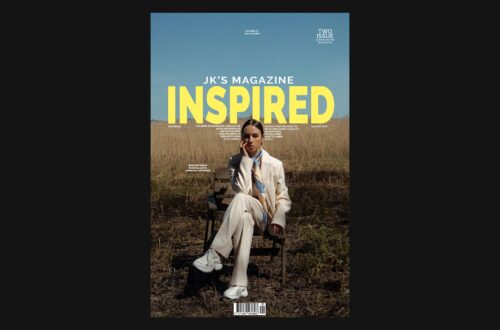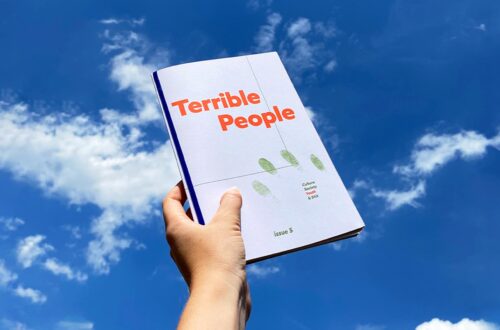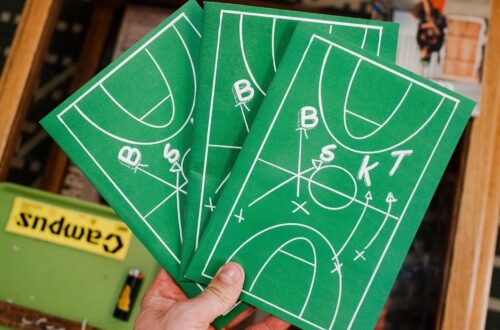
Finger Food magazine creates a home for food and design to thrive
Finger Food Magazine is not your usual food magazine. The green border outlines a striking image dressed with a red curtain sitting behind a table set with interesting food and drink items. The art direction is an indication of the type of artwork that can be held within, but by setting us a table, we’re ready to pick up our cutlery and get stuck in. The back cover of Finger Food Magazine issue one reads, “a space for stories, artwork and essays, in any and all mediums, exploring craft, cooking and creation.” The space they describe is a creative journey of personal stories and curated photography – like opening up a family album of food memories.
On the face of it – the cover, we see a photograph by Lydia Whitmore with rolled up spaghetti and fresh tomatoes sitting around the tight coil of pasta – a small tower of winding yellow strings with olives aloft. The styling by Anna Sheridan sees a fork set to the side of the plate and has the pasta twined around it, paused in time at the start of the meal. The red curtain behind the table sets the scene, with a lace tablecloth above a pastel pink cloth. Olives sit in another serving bowl, with an open drink can of grapefruit next to a metal tin. The lighting is almost nostalgic and the soft textures help the strong contrasting light source compliment the objects on show. The food in the shot is made by Barney Pau, the creative director and designer of Finger Food.


The ‘Home Haute Cuisine’ piece continues inside from page 14 and holds further images related to the “supermarket items” paraphrased from Lydia’s quote, “every day supermarket items elevated.” We see these items presented in a “higher” design, making the homemade food we cooked during lockdown (the public health measure during the Covid-19 pandemic) find a higher purpose, without the expenses associated with food presented in a luxurious setting. The colour grading of the images add to the texture and feel of the piece, whilst the first piece of the magazine hosts black and white, low contrast photos that have a vintage quality to them. ‘Insect nibbled, wonky, delicious’ by Hannah Morgan is a reflection of the lockdown period and their reconnection during that time with nature and the “endless beauty that is all around us.” The new found appreciation was sparked by spending more time in nature and the creatures “we share this planet with”, she notes.
The world of homegrown food is also referenced in Hannah’s piece. “This period of time also provided me with a rare opportunity to reconnect with my mother in her beloved garden,” she adds. In reference to the image series containing black and white shots of weeds and natural roots. “She taught me to prune, weed, sew seeds and harvest vegetables and fruit.” Enjoying the harvested food from its source is an obvious passion for Hannah and is one that is “nurtured” following this experience. That family connection also reappears later in Finger Food, and is a common factor in food memories and of course, childhood. ‘Na Ručak kod Bake i Deke’ by Nina Vukadin is a long form poem accompanied by imagery and other text. For this piece we’re invited into a personal project of observation and family connection. Focused on their grandparents, we join a narrative describing the experience of cooking, under experienced hands. “You need the person to make it whole, her hands, her touch, her care”, Nina writes. The piece is an emotional storytelling, telling us that their food can never be made in the same way, other than by her beloved family member.
We also experience the extraordinary in the culinary world with the photo series for ‘Dormant’ from page 32. Barney Pau heads up the food photography, whilst the piece itself is another by Hannah Morgan. Inspired by a trip to Devil’s Dyke in the South Downs of Sussex, the food is inspired by the photographs from the Autumnal walk. Beautifully crafted, the images are from the creative brain of Barney, who has curated meals such as walnut and mushroom tapenade and unami crackers, amongst other ingredients, served with a foraged mushroom broth. The lighting, art direction and compositional work in the images are another prize to behold, to match that of the front cover’s imagery counterparts; you can see them in a high-end restaurant without much imagination.
"Finger Food offers a range of topics within food - especially when we read Jo’s piece on edible flowers that can also contain healing properties, or current topics such as sustainability and even slaughter."
Stuart Williams, owner of Overleaf



Leaving nothing to the imagination is another trait found in an earlier piece in issue one. Named ‘How to knock your hog’, the article sees the Editor Kit Jury Morgan discussing how the slaughtering of pigs work in this day and age. In expectation, this knowledge wouldn’t be your common family meal discussion point, however it is no less of an important one. The humane aspect is discussed, from the sharp knife technique to modern technology to help with the quantity going to slaughter – the productivity of the people doing the act, as it were. Within the relative calmness of slow, atmospheric photo spreads, the hog slaughter topic is a surprise and is a gripping double page spread. Asking the important questions warrants important answers and this is how Kit’s piece speaks to the manual labour of a lot of the articles in the issue – from homegrown to handmade, we are culpable from abattoir to plate.
The debut issue of any magazine is a dive into the unknown. Each turn of the page transporting us to the vision of the creator’s and the contributors; a community effort that holds our attention in the physical realm. We can pause for reflection in pieces such as Nina’s poem, dive into greenery in Toby Jury Morgan’s piece named ‘Untitled’ or explore the power of flowers with Jo Edwards. Finger Food offers a range of topics within food – especially when we read Jo’s piece on edible flowers that can also contain healing properties, or current topics such as sustainability and even slaughter. There are surprising twists and turns as personal artefacts mix with factual long form writing – the emotional with the emotionally void. The void however is where Finger Food expels its greatest asset – the underlying passion for food as a design practice and our planet’s diversity.
Brand new issue two was released in late 2023 and is available to order on Finger Food’s official shop. You can also buy a bundle (at time of writing) including issue one and issue two, available here.
Where to buy
Here are the stockist websites for this magazine title. These may include social media links only.
Finger Food Magazine – Official Website
Correct at time of writing.
Sponsor this article
Advertise your goods or shop here! Contact Overleaf via overleafpodcast@gmail.com with the subject line ‘Article Sponsorship’ to find out more.
Enjoying Overleaf?


You May Also Like

JK’s Magazine issue two aims to inspire through a diverse creative showcase
February 6, 2023
Terrible People dives into the theme of youth in new issue and introduces Mean Mail collaboration
March 24, 2023